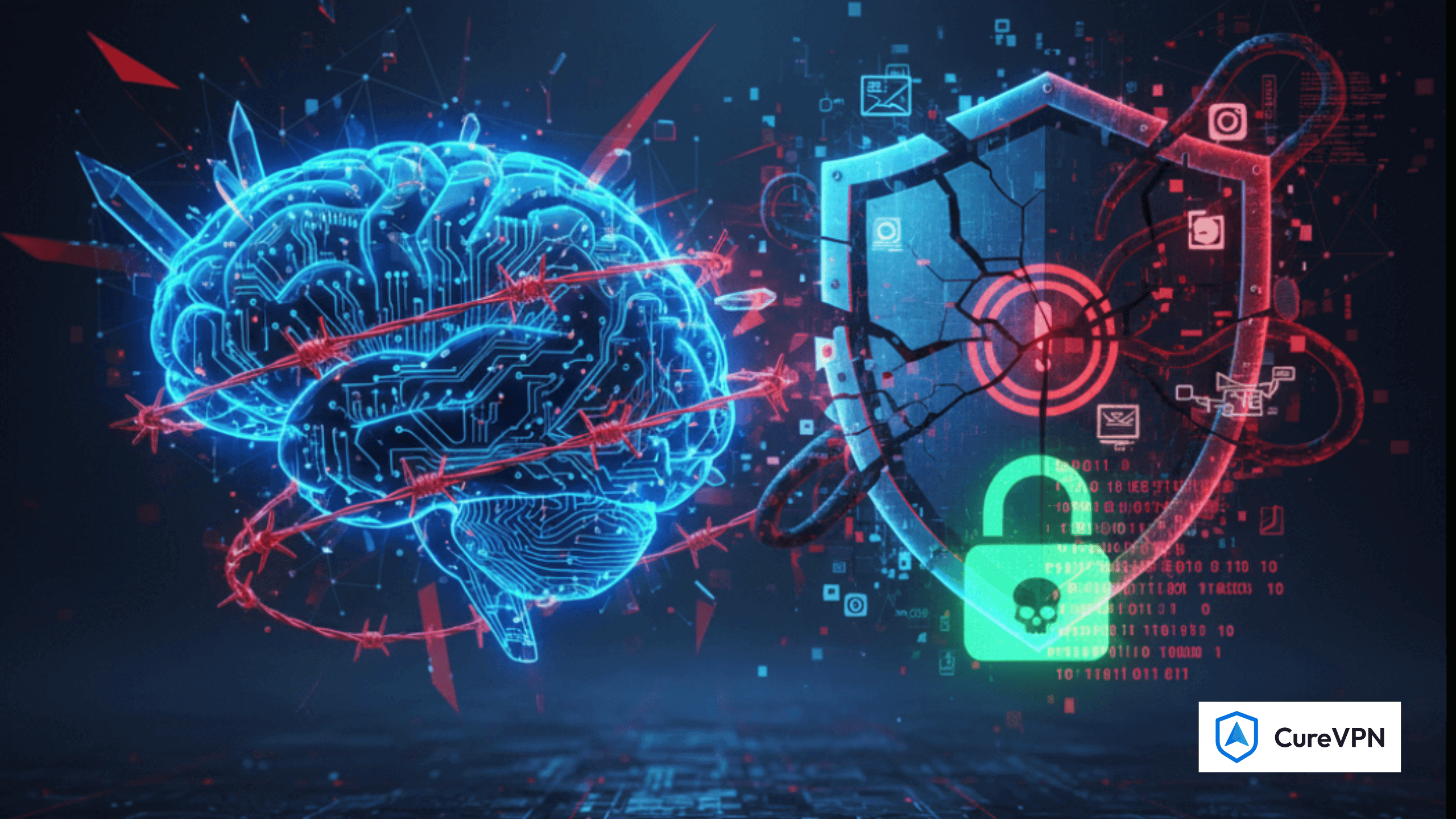Artificial Intelligence (AI) has become one of the most transformative forces of our time, revolutionizing industries from healthcare to finance. But in the digital security space, its impact is both promising and concerning. While AI helps organizations detect threats faster, respond in real time, and automate defenses, it also introduces new vulnerabilities and risks that were previously unimaginable.
Cybercriminals are no longer just exploiting outdated software or weak passwords—they’re leveraging AI itself to launch more sophisticated, adaptive, and scalable cyberattacks. From deepfake-powered fraud schemes to AI-driven phishing campaigns, attackers are using the same technology that enterprises rely on for defense.
This dual nature of AI—a tool for both protection and exploitation—is why cybersecurity concerns with AI are at the top of every CISO’s priority list in 2025. Gartner predicts that by 2026, over 60% of enterprises will rely on AI for cybersecurity operations, yet reports also warn that AI-powered attacks will increase in frequency and scale.
The takeaway is clear: businesses and individuals must understand not only the benefits of AI in cybersecurity but also its risks. Awareness is the first line of defense. In this article, we’ll explore the opportunities, challenges, and real-world threats posed by AI, while providing strategies to stay secure in an AI-driven digital landscape.
The Rise of AI in Cybersecurity
AI is no longer a futuristic concept—it’s already reshaping how organizations defend their digital assets. Over the last decade, cybersecurity has shifted from reactive defenses to proactive, AI-driven systems capable of detecting anomalies, predicting threats, and even autonomously neutralizing attacks.
Why AI Matters in Cybersecurity
Traditional security tools often struggle with speed, scalability, and accuracy. Human analysts can’t manually sift through millions of daily alerts or analyze the massive datasets generated by modern IT environments. This is where AI excels:
- Pattern recognition – AI can spot irregular behaviors across networks that may signal intrusions.
- Real-time monitoring – It continuously scans traffic and systems, detecting suspicious activity instantly.
- Adaptive learning – Unlike static rules-based systems, AI improves as it encounters new threats.
AI in Action Today
Some of the most widely adopted use cases include:
- Threat Detection & Prevention: Identifying malware signatures, insider threats, or unusual login attempts.
- Automated Response: Isolating infected devices or blocking malicious IPs without human intervention.
- Fraud Prevention: Banks use AI to flag unusual spending patterns in milliseconds.
- User Authentication: AI-driven biometric systems help prevent identity theft.
The Double-Edged Sword
While the rise of AI in cybersecurity has strengthened defense capabilities, it has also created an arms race. Cybercriminals now leverage AI to bypass firewalls, mimic legitimate behavior, and develop AI-powered attacks at scale. This tug-of-war highlights why understanding cybersecurity concerns with AI is critical for every business leader, IT professional, and even everyday internet user.
Benefits of AI in Cybersecurity
Artificial Intelligence has transformed how organizations detect, prevent, and respond to cyber threats. Instead of relying solely on manual monitoring or static security tools, businesses now use AI to create smarter, faster, and more reliable defenses. Understanding these benefits helps explain why AI adoption in cybersecurity is accelerating worldwide.
1. Enhanced Threat Detection
AI systems can analyze massive volumes of data in real time, spotting anomalies that might indicate cyberattacks. For example:
- Detecting unusual login attempts at odd hours.
- Identifying traffic patterns that resemble DDoS (Distributed Denial of Service) attacks.
- Recognizing new forms of malware that traditional signature-based tools miss.
This proactive detection helps reduce false negatives and ensures organizations can respond before damage occurs.
2. Faster and Automated Incident Response
Time is everything in cybersecurity. The longer a breach goes unnoticed, the greater the potential damage. AI helps by:
- Isolating compromised devices immediately.
- Blocking malicious IPs before they spread infections.
- Quarantining suspicious files for further inspection.
This automation not only reduces response times but also minimizes reliance on overworked human analysts.
3. Continuous Learning and Adaptability
Unlike static systems, AI evolves with every new dataset and cyberattack attempt. Using machine learning models, AI tools become better at predicting and neutralizing future threats. This adaptability ensures long-term protection even as attack vectors grow more complex.
4. Improved Accuracy and Reduced False Positives
One of the biggest challenges for security teams is the overwhelming number of false alarms. AI uses advanced algorithms to differentiate between genuine threats and harmless anomalies. This reduces alert fatigue and helps teams focus on real risks.
5. Cost Efficiency and Resource Optimization
AI may require upfront investment, but in the long run, it helps companies save millions by:
- Preventing large-scale breaches.
- Reducing the need for massive security teams.
- Allowing staff to focus on strategic initiatives rather than repetitive tasks.
Real-World Example
A global financial institution integrated AI-driven fraud detection. Within months, it reduced fraudulent transactions by over 60%, saving millions of dollars while enhancing customer trust.
Potential Risks of AI in Cybersecurity
While Artificial Intelligence strengthens defenses, it also introduces new vulnerabilities and risks. Hackers are quick to exploit AI systems, and in some cases, AI itself becomes a double-edged sword. Understanding these risks is critical to addressing cybersecurity concerns with AI.
1. AI Vulnerabilities and Exploits
AI models are only as strong as the data and algorithms they rely on. Attackers can exploit weaknesses through:
- Adversarial attacks – feeding manipulated data to trick AI into making wrong predictions.
- Model poisoning – injecting malicious data into training sets to influence AI decision-making.
- Bypassing detection – using AI-generated malware designed to evade traditional defenses.
For example, researchers have shown how small data alterations can cause image-recognition AI to misclassify objects—a dangerous prospect if applied to malware detection systems.
2. Malicious Use of AI by Hackers
Cybercriminals are adopting AI to create more sophisticated attacks:
- AI-driven phishing campaigns craft emails that mimic real writing styles, making scams nearly indistinguishable from genuine messages.
- Deepfake technology can impersonate executives to manipulate employees into transferring funds (a rising trend in business email compromise attacks).
- Automated malware adapts in real time to avoid detection, making it harder for defenders to respond.
This demonstrates that AI isn’t just a defensive tool—it’s also in the hands of attackers.
3. Over-Reliance on Automation
AI’s automation can create a false sense of security. Organizations sometimes assume AI will solve all problems, neglecting human oversight. This leads to:
- Delayed response to complex, non-standard attacks.
- Security blind spots when AI fails to recognize unique threats.
- Complacency within IT teams, weakening overall resilience.
4. Data Privacy Risks
Since AI depends on large datasets, it often collects and processes sensitive personal information. If not properly secured, this data may:
- Be exposed in a breach.
- Be misused for surveillance or profiling.
- Violate privacy regulations like GDPR or CCPA.
Mismanagement of personal data not only damages trust but can also lead to legal penalties.
5. High Costs and Resource Demands
Although AI improves efficiency long-term, building and maintaining these systems requires:
- Skilled professionals (data scientists, AI engineers, cybersecurity experts).
- Continuous training of models to remain effective.
- Substantial infrastructure investment.
For small businesses, these costs can be prohibitive.
AI-Powered Attacks
Among the most pressing cybersecurity concerns with AI are AI-powered attacks—threats that use artificial intelligence to become more adaptive, scalable, and nearly undetectable. Unlike traditional attacks, these threats continuously learn, evolve, and exploit system weaknesses in real time.
Deepfake Attacks
Deepfakes leverage generative AI to create hyper-realistic fake audio, video, or images. While some are used for entertainment, in the wrong hands, they become powerful weapons.
- Fraud & Financial Crime: Cybercriminals impersonate CEOs or government officials in video calls to authorize fake transactions (known as deepfake CEO fraud).
- Disinformation Campaigns: Manipulated videos can sway public opinion, disrupt elections, or spread propaganda.
- Identity Theft: Attackers use deepfake voices to bypass voice authentication systems at banks or call centers.
According to Europol, deepfakes are emerging as a major national security risk, with the potential to undermine trust in digital communication and democratic systems.
AI-Driven Phishing
Phishing has long been one of the most common cyberattacks, but AI has taken it to the next level.
- Hyper-Personalization: AI analyzes publicly available data (social media, corporate websites, leaked datasets) to craft emails that sound exactly like a trusted colleague or service provider.
- Automated Scaling: Attackers can send thousands of unique phishing messages, each tailored to its recipient, making detection harder.
- Convincing Language Models: AI mimics natural writing styles and avoids the spelling errors and awkward phrasing that used to give phishing attempts away.
For example, Microsoft has warned that AI-enhanced phishing campaigns are increasingly bypassing traditional spam filters, putting even tech-savvy users at risk.
Why AI-Powered Attacks Are Harder to Detect
Unlike conventional cyberattacks, AI-powered threats:
- Adapt instantly to defenses.
- Look more “human” and less suspicious.
- Operate at massive scale, targeting individuals, businesses, and governments simultaneously.
This makes them one of the fastest-growing cybersecurity risks in today’s digital landscape.
Challenges in AI Integration
While AI has become a powerful tool in enhancing cybersecurity, integrating it into security systems isn’t without hurdles. Businesses often underestimate these obstacles, leading to poor implementation or overreliance on technology. Understanding these cybersecurity concerns with AI helps organizations prepare more effectively.
High Implementation Costs
Adopting AI-driven cybersecurity solutions can be expensive.
- Advanced infrastructure: AI requires significant computing power, data storage, and real-time analytics capabilities.
- Skilled workforce: Hiring and retaining AI engineers and security analysts adds to the costs.
- Ongoing expenses: AI models need regular updates and retraining to remain effective against evolving threats.
For small and mid-sized businesses, these costs can make AI adoption seem out of reach without the help of white-label or managed solutions.
Lack of Transparency (The “Black Box” Problem)
Many AI algorithms operate as a “black box,” meaning their decision-making process is not fully explainable.
- Security teams may struggle to understand why an AI flagged a certain activity as malicious.
- Lack of explainability can slow down incident response.
- It raises compliance concerns, especially in industries regulated under GDPR or HIPAA.
This challenge makes it harder to build trust in AI-powered systems.
Data Privacy Risks
AI models depend on large datasets to detect threats effectively. However:
- Collecting and storing sensitive user data increases the risk of breaches.
- Misconfigured AI tools could inadvertently expose personal or proprietary information.
- In some cases, AI training datasets themselves can become targets for attackers.
Balancing effective AI-driven security with data privacy laws is a constant struggle.
Over-Reliance on AI
Another growing concern is businesses assuming AI can fully replace human security experts.
- AI can automate detection but lacks the intuition of experienced analysts.
- Sophisticated attackers often combine technical and psychological tactics (like social engineering), which AI alone may not catch.
- Human oversight is still crucial for ethical, legal, and strategic decision-making.
Without skilled professionals to interpret AI outputs, organizations risk blind spots in their defenses.
Ethical Concerns in AI and Cybersecurity
Beyond the technical hurdles, one of the most pressing cybersecurity concerns with AI lies in the ethical challenges. As AI becomes more embedded in digital defense systems, organizations must carefully balance innovation with responsibility.
Bias in AI Algorithms
AI systems are only as good as the data they’re trained on. If the dataset is biased or incomplete:
- Certain threats may be overlooked, leaving gaps in protection.
- False positives may rise, creating “alert fatigue” for security teams.
- In global businesses, biased AI models may struggle to detect threats across diverse languages or regions.
Ethical AI requires building datasets that are diverse, representative, and continuously updated.
Job Displacement Concerns
As AI automates many tasks traditionally handled by humans, there’s growing fear of job loss in cybersecurity roles.
- Routine monitoring, log analysis, and basic threat detection are increasingly AI-driven.
- While AI reduces workload, it risks minimizing opportunities for junior analysts entering the field.
- This shift raises ethical questions about workforce reskilling and job transition planning.
The reality: AI won’t eliminate jobs but will transform them. Human expertise remains essential in areas like ethical decision-making and advanced incident response.
Accountability in Case of Failures
When AI fails, who is responsible?
- If an AI-driven system misclassifies an attack, leading to a breach, is the fault with the vendor, the developers, or the business using it?
- Lack of clear accountability frameworks raises concerns for regulators, insurers, and consumers.
- Organizations must establish transparent policies outlining liability before deploying AI at scale.
Potential for Misuse
The same AI tools that defend systems can also be exploited by attackers.
- Hackers use AI to create convincing phishing emails, deepfakes, and even automated malware.
- State-sponsored groups may weaponize AI for cyberwarfare.
- Without ethical oversight, AI could escalate the sophistication and frequency of cyberattacks worldwide.
This dual-use dilemma makes responsible AI governance more critical than ever.
Future of AI in Cybersecurity
As cyber threats evolve, AI is set to play an even more central role in building resilient defense systems. While challenges remain, the future of AI in cybersecurity looks promising, with advancements pointing toward smarter, faster, and more adaptive protection strategies.
Predictions and Emerging Trends
- Hyper-Automation of Threat Response: AI will move beyond detection to fully automated incident response, minimizing downtime and reducing human intervention.
- Adaptive Learning Models: Future AI systems will learn in real time, continuously adapting to new attack vectors instead of relying solely on pre-trained datasets.
- Integration with Quantum Computing: As quantum technologies mature, AI will gain the computational power to detect and mitigate complex threats at an unprecedented scale.
- Privacy-First Security: With rising concerns about surveillance, AI-driven cybersecurity will increasingly prioritize privacy compliance (GDPR, CCPA, and beyond).
The Road Ahead for Organizations
Organizations that embrace AI in cybersecurity today are laying the foundation for long-term resilience. Key strategic shifts include:
- Investing in AI-powered Security Tools: Early adoption allows businesses to refine systems and build internal expertise.
- Building Human-AI Collaboration: AI handles scale, while humans oversee ethics, context, and strategic decisions.
- Continuous Training & Awareness: Both machines and humans need regular updates—AI through retraining models, employees through cybersecurity awareness programs.
- Preparing for Regulation: Governments are already drafting AI regulations, and businesses must align early to avoid compliance risks.
Long-Term Outlook
The future of AI in cybersecurity will not be about replacing humans but empowering them. AI will act as a force multiplier, augmenting human decision-making, reducing errors, and allowing teams to focus on strategic threats rather than routine tasks.
Organizations that balance innovation with ethical responsibility will not only strengthen their defenses but also build trust with customers in an increasingly digital-first world.
Final Thoughts & Conclusion
Artificial intelligence is no longer just a buzzword in the security world—it has become a cornerstone of modern defense strategies. From real-time threat detection and predictive analysis to automated responses, the role of AI in cybersecurity is rapidly expanding.
However, as powerful as AI is, it is not a silver bullet. Human expertise, ethical oversight, and compliance with global privacy laws remain essential for creating a balanced and trustworthy security framework. The future of AI in cybersecurity lies in collaboration, not replacement—machines handling scale and speed, while humans provide judgment and context.
For organizations, the message is clear:
- Adopt AI early to gain a competitive edge in resilience.
- Train teams alongside technology to maximize efficiency.
- Stay compliant and transparent to build long-term trust.
The cyber battlefield is evolving, and so are the tools to defend it. By embracing AI thoughtfully and strategically, businesses can not only protect themselves from ever-changing threats but also unlock opportunities for innovation and growth.
In the end, the question is no longer if AI will shape the future of cybersecurity—but how prepared your organization is to harness it.





